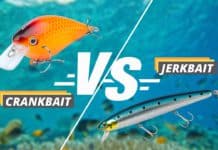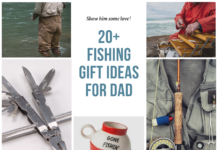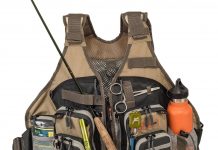Catching striper or redfish can be daunting if you’re a newbie and unfamiliar with the right fishing equipment and ideal surroundings. Luckily, having a fish finder rig can make the entire process less daunting. The best part? You’ll only assemble seven parts, three of which are already in your fishing gear.
What Is a Fish Finder Rig?
Using a fish finder rig is popular for catching fish like redfish and stripers. It is also ideal for large pieces of bait because the angler can drop back into a biting fish and give it time to ingest the bait.
A typical fish finder rig comprises a line, hook, sinker, bobber, swivel, lure, beads, and other tackle. All these components work together to make surf fishing easier and manageable. Keep in mind that there are a variety of hooks, lines, and weights that work with the rig, but the concept remains the same: cast your bait into the water far enough that it will sink without being swept away.
What Are the Parts of a Fish Finder Rig?

A fishing rig combines sinkers, fishing lines, swivel, beads, hooks, sinkers. You can also add a cork or bobber, or in some cases, a second hook.
Pyramid Sinker
Pyramid sinker is popular for pier and surf fishing. Its function is to hold the line down in the water. They are triangular and tapered shape weights that pierce through the water, digging into the sand. Since it has flat edges, rough waves do not move it much. The same holds true for sand and rough currents, including the surf. With this sinker, you can catch anything from perch in the surf to sharks on the pier.
Beads
Problem: As the large hole of the sinker moves up or down the line, it can hit the knot, causing unwanted friction and wear on the knot, leading to a broken line. Solution: Anglers attach a bead between the sinker and the knot. The sinker hole and bead diameter differ in size, resulting in the sinker stopping at the bead, which protects the knot in the leader.
Swivel
A swivel comprises two rings attached to a pivoting joint. It has a round or barrel-shaped pivot joint that holds a reel and a rod on one end and a lure, hook or sinker on the other. Swivels enable lines to untwist during retrieval, preventing unnecessary tangles. Additionally, it prevents the line from twisting during rough surf or when fighting large fish.
Leader Line
For most fishing applications, it is standard practice to tie a bait directly to the main line. However, there are some applications where a leader line is necessary to catch fish. In a fishing rig, you’ll use a leader line to connect the lure or hooks on one end and the main line on the reel on the other. Typically, the two lines are connected with a knot or by tying each line to a swivel.
Hook
Circle hooks work best with a rig since they do not require setting when something bites, which is advantageous when using a fish finder’s bench. It is also useful for attaching many types of surf fishing bait to your fish rig and preventing bait from falling off. The bait is also easier for fish to eat without feeling the hook immediately.
Sinker Slide
Sinker slides are plastic sleeves attached to pyramid sinkers. It can accommodate many different types of weight and is compatible with most catfish rigs. They also make changing weights simple. You need to ensure that your sinker slides easily along the main line. When the water is rough, pyramid sinkers hold their position better on the bottom, so your bait is within striking distance.
Float
If you frequently lose your bait to shrimp or other species, place a float near your hook. Fishing floats can be attached to a fishing line for the below purposes:
- A float allows a baited hook to rest at a predetermined depth.
- The float’s buoyancy allows the baited hook to reach otherwise inaccessible water areas by drifting in the current.
- Floats also serve as a visual indication of a bite.
How to Tie a Fish Finder Rig
Fish finder rigs are popular surf fishing rigs used to locate fish schools. It is often used along with a pyramid weight to keep the rig in one area. This step-by-step guide to a fish finder rig setup.
- Cut approximately 18 inches of leader line.
- Make a Palomar Knot at one end of your hook.
- Tie your swivel to the other end of your leader line with a Palomar Knot.
- Fish the mainline through the pyramid sinker and the bead.
- Using a Palomar Knot, tie the main line to the other side of the swivel. The Palomar is a bit tricky because you have to pass the entire leader, including the hook, through the knot, but just take your time.
How to Cast and Use a Fish Finders Rig
Fish rig casting can be challenging depending on the weight being used and the length of the leader. You should not use a weight and braid that exceed two ounces. If your leader is longer, wind resistance will increase, reducing your casting range. With rigging clips, you can keep everything streamlined until the cast hits the water, allowing you to cast easier. Below are steps to casting and using a fish rig.
- Choose a shoreline with a little underwater cover like weeds, rocks, and coral.
- Make sure you cast your fish rig as far out into the surf as you can or to any of the above areas.
- Now you wait!
- Check your rod’s tip if you notice anything out of the ordinary.
- Checking bait every 20 to 30 minutes.
- If you do not catch any fish at a particular location, move down the beach after a few hours.
- If your lure keeps falling off, use a foam float for your leader of 2 inches to 3 inches.
Fish Finder Rig FAQ
Do Fish Finder Rigs Work?
The fish-finder rig is effective on a wide range of fish, but you should adjust the hook size and leader length according to the species. Longer leaders reduce casting distances due to wind resistance. Anglers must use circle hooks when fishing for striped bass with bait.
What Is a Fish Finder Rig for Stripers?
When targeting stripers, you will need a more robust rig. If you plan to use your sliding sinker to catch fish, you will need a 100-300 pound barrel swivel tied to a braided mainline. A 6 to 30 inch-30-60 pound fluorocarbon is recommended. Use a circle hook. Choose the hook size according to the fish you are targeting.
What Is the Difference Between a Carolina Rig and a Fish Finder Rig?
The Fish Finders Rig uses a pyramid weight to keep the rig in one location, whereas a Carolina Rig uses a sliding egg sinker. As both use multiple knots between the hook and mainline, they are prone to breaking. Additionally, the weight of the fish finder rig surf can become a stress point if it becomes entangled in structure or gets tossed around violently.
Conclusion
If you love surf fishing or want to catch your first striper or redfish, you should definitely try a fish finder rig. The parts will only take a few minutes to assemble but are effective for your preferred type of fishing. Remember, keep the weight and braid at two ounces and the leader line at approximately 18 inches.
Table of Contents



